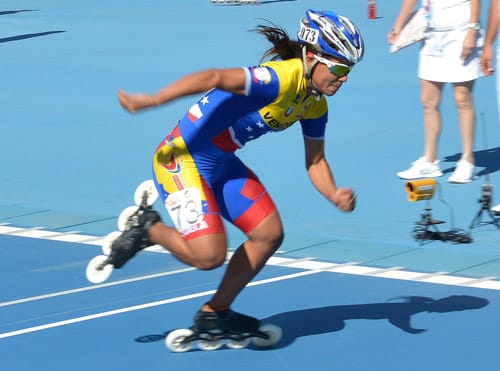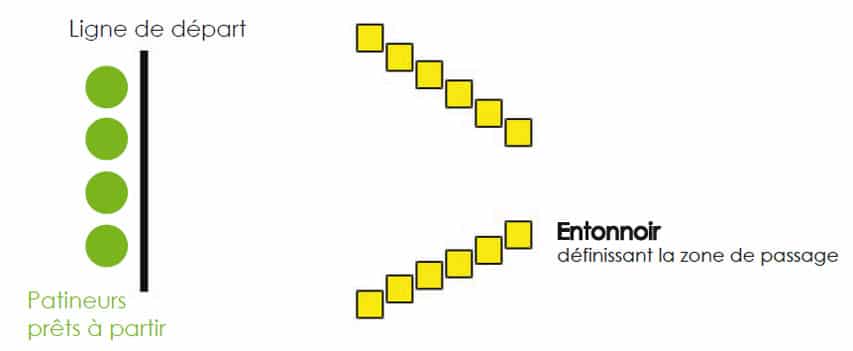Reaction time : the importance of the first 10 meters
On a sprint, the success of the start is determining. It can condition a good placing in a pack. Sila Coaching offers this theme card to coaches to help them improve the start technique of their skaters...
Par alfathor
In practice
 Many athletes have won competitions thanks to their great start. Reaction time is one of the key points for a successful start. It is important to work on it meticulously.
Many athletes have won competitions thanks to their great start. Reaction time is one of the key points for a successful start. It is important to work on it meticulously.
Sila Sport shares this theme card with ideas of drills, in order to develop the key skills of reaction time. All the drills below are organized in standing starts on 20 m, with preferably several athletes lined up.
Warming up is essential
- At least 10 min at a constant speed, on or off skates.
- Warming up your adductors with specific and active moves.
- Drills to increase your hear rate.
- Several starts in progressively increasing the intensity.
Objectives
- Developing your concentration
- Developing your reactivity
- Increasing your general speed

Equipment
Whistles – Jerseys / Scarves – Cones
Places
Practice places advised for the drills
Track – Road – Road circuit – Indoor
Concentration drills
Visual drills
 Drill 1 : Use a visual item, like a scarf. When the coach waves the scarf, the athletes launch a 20 m sprint from a standing start.
Drill 1 : Use a visual item, like a scarf. When the coach waves the scarf, the athletes launch a 20 m sprint from a standing start.
Drill 2 : Same as Drill 1 but with items of different colors. The athletes should start only when the coach shows the right color defined for the start.
Hearing drills
Drill 1 : use a hearing item like a whistle. When the coach blows the whistle, the athletes launch a 20 m sprint from a standing start.
Drill 2 : Same as Drill 1 but with different sounds (whistles with different pitches, honks etc.) The athletes should start only when they hear the right sound defined for the start.
Variation
In order to increase the difficulty, you can use both visual and hearing signals on a same drill. Vary and change the types of signals regularly.
Reactivity drills
Reaction time determines the efficiency in the first 20 meters of a race. Those first meters will make the difference. It is important to raise awareness among your athletes on the fact that, most of the time, the ranking at the exit of the first bend is the same as the final ranking of the race.
Start drills
Drill 1 : Ask your athletes to place themselves in specific postures so that they are put in a difficult position at the start : sitting, cross-legged, lying on their backs, on their stomachs…
Drill 2 : Give them a task to do during or before the start : getting up without their hands, doing a push-up, touching the wall before starting, placing a ball at a specific place…
Funnel drills
Define a funnel-shaped area for the racing skaters. It may be more or less wide, and more or less close from the start line. The goal is to be the first to pass in the defined area. The closer the area will be from the start line, the more important reaction time will be as for the successful execution of the drill. Always work on a 20 m distance (more or less).

Start line | Skaters ready to go | funnel-shaped area to be passed
Repeated reaction time
Repeat starts with very little rest time. The aim is to tire your organism while keeping a high level of reactivity. You can do short starts, go to and fro, or sideways…
Game of the missing cone
Line up your skaters on a start line. Place as many cones as there are skaters, minus 1, at about 20 meters from the line. At the start signal, defined by the coach, all the skaters go and get a cone. The skater who didn’t get any cone is eliminated. This game is preferably to be done at the end of a training so that the eliminated skaters do not feel excluded from the drill. Once they are eliminated, they can take their skates off.
Extra tips
In order to increase the difficulty, you can also vary the size of the start zone, that is to say : placing the skaters closer together on the line, and regularly change the start positions and start signals.
The + of Sila Sport
No equipment, visual or hearing ? Vary your signals with items within your reach :
- A set of keys
- Whistle
- Clap your hands
- Drop something to the ground
Not enough skaters to make level groups ? Give disadvantages to the best skaters : Starting 1 m further, and other obstacles…
No equipment ? Leave all kinds of objects on the ground to generate various types of adaptations…
We would advise you to allocate 20 to 30 min to the theme of this card.
Afterwards…
- Finish your training with games or fun drills to relax : games of skill, etc.
- Specific stretching : Stretching of the lower limbs and of the upper body, for which those types of drills are very demanding.
Useful links
The ‘Learning speed skating’ OLS section
Download the presentation card of SILA Coaching (in French)
Download this theme card in .pdf (in French)
Photos: Renaud Cornet, Sila Sport
Rafael Leyton – rollerenligne.com
